
A bracelet is an article of jewellery that is worn around the wrist. Bracelets may serve different uses, such as being worn as an ornament. When worn as ornaments, bracelets may have a supportive function to hold other items of decoration, such as charms. Medical and identity information are marked on some bracelets, such as allergy bracelets, hospital patient-identification tags, and bracelet tags for newborn babies. Bracelets may be worn to signify a certain phenomenon, such as breast cancer awareness, or for religious/cultural purposes.

A drink can is a metal container designed to hold a fixed portion of liquid such as carbonated soft drinks, alcoholic drinks, fruit juices, teas, herbal teas, energy drinks, etc. Drink cans are made of aluminum or tin-plated steel. Worldwide production for all drink cans is approximately 370 billion cans per year.
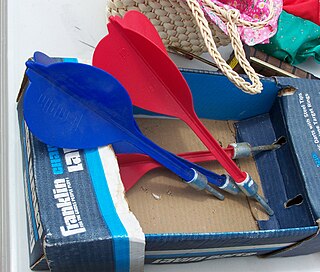
Lawn darts is a lawn game for two players or teams. A lawn dart set usually includes four large darts and two targets. The game play and objective are similar to those of both horseshoes and darts. The darts are typically 12 inches (30 cm) in length with a weighted metal or plastic tip on one end and three plastic fins on a rod at the other end. The darts are intended to be tossed underhand toward a horizontal ground target, where the weighted end hits first and sticks into the ground. The target is typically a plastic ring, and landing anywhere within the ring scores a point.

A product recall is a request from a manufacturer to return a product after the discovery of safety issues or product defects that might endanger the consumer or put the maker/seller at risk of legal action.

Cufflinks are items of jewelry that are used to secure the cuffs of dress shirts. Cufflinks can be manufactured from a variety of different materials, such as glass, stone, leather, metal, precious metal or combinations of these. Securing of the cufflinks is usually achieved via toggles or reverses based on the design of the front section, which can be folded into position. There are also variants with chains or a rigid, bent rear section. The front sections of the cufflinks can be decorated with gemstones, inlays, inset material or enamel and designed in two or three-dimensional forms.

Wristbands are encircling strips worn on the wrist or lower forearm. The term may refer to a bracelet-like band, similar to that of a wristwatch, to the cuff or other part of a sleeve that covers the wrist, or decorative or functional bands worn on the wrist for many different reasons. Wristbands are often worn and used similarly to event passes such as lanyards to information or allow people entry to events. These wristbands are made from loops of plastic that are placed around the wrist and are used for identification purposes.

Gel bracelets are a type of wristband often made from silicone.
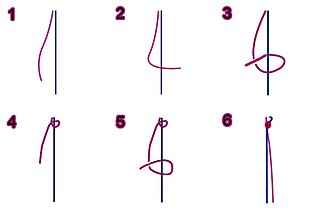
A friendship bracelet is a decorative bracelet given by one person to another as a symbol of friendship. Friendship bracelets are often handmade, usually of embroidery floss or thread and are a type of macramé. There are various styles and patterns, but most are based on the same simple half-hitch knot. They represent a friendship that is strong and everlasting.
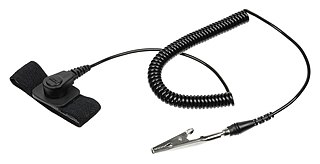
An antistatic device is any device that reduces, dampens, or otherwise inhibits electrostatic discharge, or ESD, which is the buildup or discharge of static electricity. ESD can damage electrical components such as computer hard drives, and even ignite flammable liquids and gases.

Toy safety is the practice of ensuring that toys, especially those made for children, are safe, usually through the application of set safety standards. In many countries, commercial toys must be able to pass safety tests in order to be sold. In the U.S., some toys must meet national standards, while other toys may not have to meet a defined safety standard. In countries where standards exist, they exist in order to prevent accidents, but there have still been some high-profile product recalls after such problems have occurred. The danger is often not due to faulty design; usage and chance both play a role in injury and death incidents as well.
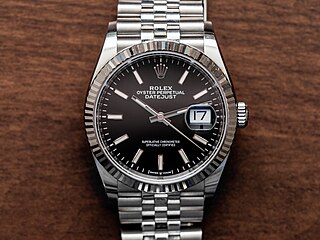
The Rolex Oyster Perpetual Datejust is a self-winding chronometer manufactured by Rolex. Launched in 1945, the Datejust was the first self-winding chronometer wristwatch to indicate the date in a window on the dial. Today, it is available in a variety of sizes from 28mm to 41mm, in stainless steel, two-tone gold, and solid gold versions.
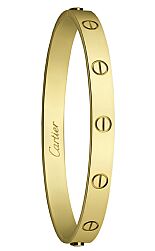
The Love Bracelet is a piece of jewelry designed in 1969 by Aldo Cipullo and offered to Cartier SA. Early versions of the Love Bracelet featured gold plating, while more recent designs are created from solid gold or platinum. Prices for the bracelets differ depending on the item's materials. As of 2019, the Love Bracelet is still in production and Cartier has expanded the line to include products based on the original bracelet's design, including cufflinks, rings, earrings, necklaces, and watches. In 2006 the line was considered to be the "most successful collection in Cartier's history."
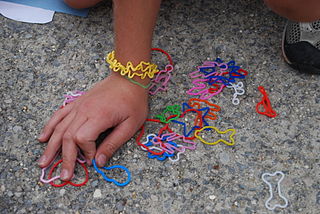
Silly Bandz are rubber bands made of silicone rubber formed into shapes including animals, objects, numbers, and letters. They are normally worn as bracelets. Silly Bandz retail in packages with select themes, such as princesses or animals, and fashion accessories. Similarly shaped silicone bands are also available under other brand names from a variety of companies. Silly Bandz were especially popular in the early 2010s.
Tiny Love is a brand of soft developmental toys and developmental activity gyms for infants and children. In 1993, Tiny Love introduced a product called the "Gymini", a portable, collapsible sensory environment for floor playtime for small babies. This has become very popular, and is their flagship product.
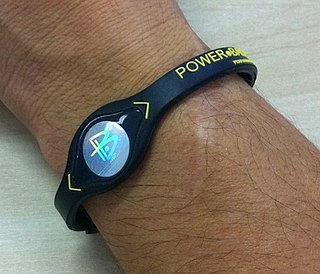
A hologram bracelet or energy bracelet is a small rubber wristband supposedly fitted with a hologram. Manufacturers have said that the holograms supposedly "optimise the natural flow of energy around the body," and, "improve an athlete's strength, balance and flexibility". Only anecdotal evidence supports these claims and tests performed by the Australian Skeptics, the University of Wales Institute, Cardiff, and the RMIT's School of Health Sciences have been unable to identify any effect on performance.
Buddy L is an American toy brand and company founded in 1920 as the Buddy L Toy Company in East Moline, Illinois, by Fred Lundahl.

Power Balance is the original brand of hologram bracelets claimed by its manufacturers and vendors to use "holographic technology" to "resonate with and respond to the natural energy field of the body" to increase athletic performance. Numerous independent studies of the device have found it to be no more effective than a placebo for enhancing athletic performance. As a result, in 2010, the Australian distributor, Power Balance Australia Pty Ltd, was forced by the Australian Competition & Consumer Commission (ACCC) to retract any previous claims.

Traditional clothing is one of the factors that has differentiated this nation from neighboring countries, dating back as far as the Illyrian era.
Rainbow Loom is a plastic tool used to weave colorful rubber and plastic bands into decorative items such as bracelets and charms. It was invented in 2010 by Cheong Choon Ng in Novi, Michigan.

A watch strap, watch band,watch bracelet or watch belt is a bracelet that straps a wrist watch onto the wrist. Watch straps may be made of leather, plastic, polyurethane, silicone, rubber, FKM, cloth, or metal, sometimes in combination. It can be regarded as a fashion item, serving both a utilitarian and decorative function. Some metal watch straps may be plated with, or even in rare cases made of, precious metals.

















